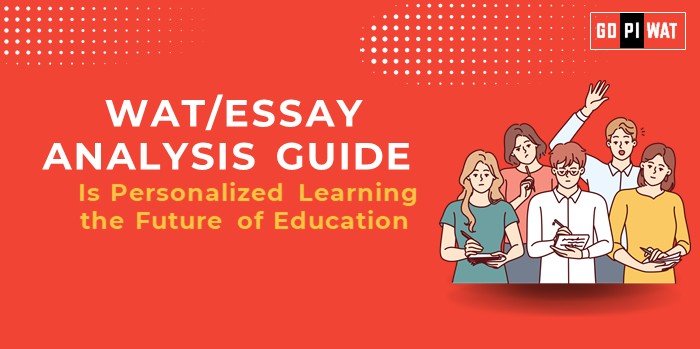📋 Is Personalized Learning the Future of Education?
🌐 Written Ability Test (WAT)/Essay Analysis Guide
🌟 Understanding the Topic’s Importance
🔍 Relevance: Personalized learning tailors education to individual student needs, influencing academic success, workforce readiness, and educational equity. Its integration into mainstream education can transform learning outcomes while addressing systemic gaps.
📝 Effective Planning and Writing
- ⏳ Time Allocation:
- Planning: 5 minutes
- Writing: 20 minutes
- Reviewing: 5 minutes
- 🔑 Preparation Tips:
- Include global success stories and regional disparities (e.g., Finland and India).
- Use statistics to substantiate arguments (e.g., engagement rates and AI impacts).
✨ Introduction Techniques
- ⚖️ Contrast Approach: “While personalized learning has improved engagement rates by 25% globally, its reliance on technology excludes millions of rural students without digital access.”
- 🚀 Solution-Based Approach: “Personalized learning can bridge educational gaps by tailoring content to individual needs, provided we address infrastructure disparities and teacher training challenges.”
📊 Structuring the Essay Body
- 🏆 Achievements:
- AI-powered platforms adapt content to individual learning styles, improving student engagement and retention.
- Global success stories like Finland integrate personalized learning with high academic outcomes.
- Increased efficiency in addressing learning gaps among diverse student groups.
- ⚠️ Challenges with Comparative Analysis:
- 📉 Access Disparities: In India, only 20% of rural households have reliable internet access.
- 🔒 Data Privacy: AI-based systems collect sensitive student information, raising ethical concerns.
- 👩🏫 Teacher Training: Educators lack the skills to integrate personalized tools effectively into traditional classrooms.
- 🚀 Future Outlook:
- 🔹 AI Integration: Advanced AI tools can revolutionize learning by aligning content with global workforce demands.
- 🔹 Equitable Access: Public-private partnerships can bridge rural infrastructure gaps and make technology inclusive.
🎯 Concluding Effectively
- ⚖️ Balanced Perspective: “While personalized learning promises transformative education, equitable access, teacher readiness, and robust data policies are vital for its success.”
- 🌍 Global Comparison: “Countries like Finland have demonstrated that inclusive personalized models, supported by infrastructure, can improve learning outcomes and workforce alignment.”
🔎 Analyzing Successes and Shortcomings
- 🏆 Key Achievements:
- Higher engagement and retention rates.
- Scalable AI-driven platforms improving individualized learning.
- ⚠️ Ongoing Challenges:
- Infrastructure gaps in rural and low-income areas.
- Cybersecurity and ethical issues around AI data usage.
- 🌍 Global Context:
- Finland: Combines creativity and technology for personalized success.
- United States: Wide disparities exist between urban and rural adoption of EdTech tools.
🚀 Recommendations for Sustainable Progress
- 🏫 Strengthen Infrastructure: Leverage public-private partnerships to ensure rural schools have access to digital tools.
- 👩🏫 Teacher Training Programs: Equip teachers to integrate AI tools effectively into classrooms.
- 🔒 Data Protection Standards: Implement ethical frameworks to safeguard student privacy.
📝 Sample Short Essays
⚖️ Balanced Perspective
“Personalized learning, driven by AI, tailors education to individual needs, improving outcomes and engagement. However, its success hinges on addressing access disparities, teacher readiness, and robust ethical frameworks for AI usage.”
🚀 Solution-Oriented
“Scalable and adaptive, personalized learning democratizes education by catering to diverse learning paces and styles. Ensuring infrastructure upgrades, teacher training, and affordable access will allow India to fully embrace this transformative model.”
🌍 Global Comparison
“Emulating Finland’s success with inclusive personalized learning, India can integrate AI-powered platforms to revolutionize its education system. Bridging access gaps and training educators will ensure long-term success in preparing a globally competitive workforce.”


